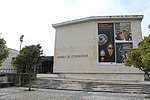Circuito de Monsanto
Defunct motorsport venuesFormula One circuitsFormula One stubsMotorsport venues in PortugalPortuguese Grand Prix ... and 2 more
Portuguese sports venue stubsSports venues completed in 1954

The Circuito de Monsanto, or Monsanto Park Circuit, was a 5.440 km (3.380 mi) race track in Monsanto Forest Park, near Lisbon, Portugal which hosted the Portuguese Grand Prix. Built on parklands, the circuit was considered difficult to drive because it crossed so many different types of surfaces, including tramlines at one point. The track hosted numerous races from 1954 to 1959, but only one race qualified as a Formula One event: the 1959 Portuguese Grand Prix, won by Stirling Moss. He won the race in the twilight hours, since the race was purposely started late in the day to avoid the intense late summer sun.
Excerpt from the Wikipedia article Circuito de Monsanto (License: CC BY-SA 3.0, Authors, Images).Circuito de Monsanto
Pista da Cordoaria, Lisbon
Geographical coordinates (GPS) Address Nearby Places Show on map
Geographical coordinates (GPS)
| Latitude | Longitude |
|---|---|
| N 38.719722222222 ° | E -9.2030555555556 ° |
Address
Pista da Cordoaria
Pista da Cordoaria
1500-225 Lisbon (Ajuda)
Portugal
Open on Google Maps








